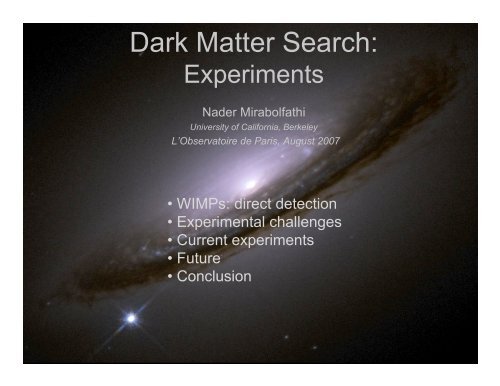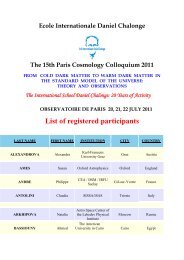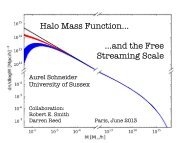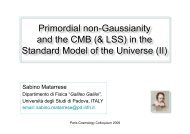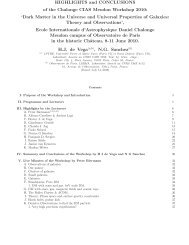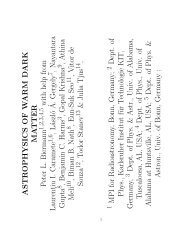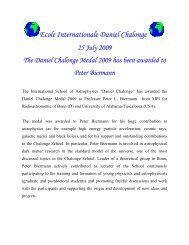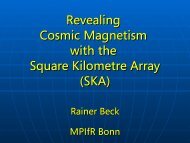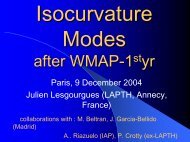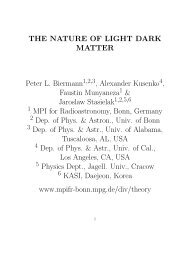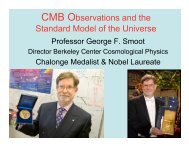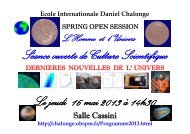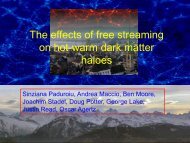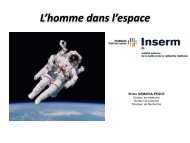Nader MIRABOLFATHI (.pdf) - Observatoire de Paris
Nader MIRABOLFATHI (.pdf) - Observatoire de Paris
Nader MIRABOLFATHI (.pdf) - Observatoire de Paris
Create successful ePaper yourself
Turn your PDF publications into a flip-book with our unique Google optimized e-Paper software.
Dark Matter Search:<br />
Experiments<br />
<strong>Na<strong>de</strong>r</strong> Mirabolfathi<br />
University of California, Berkeley<br />
L’<strong>Observatoire</strong> <strong>de</strong> <strong>Paris</strong>, August 2007<br />
• WIMPs: direct <strong>de</strong>tection<br />
• Experimental challenges<br />
• Current experiments<br />
• Future<br />
• Conclusion
W<br />
I<br />
M<br />
P<br />
For Ω χ ~0.3:<br />
Comoving Number Density<br />
σ A ~ electroweak<br />
Production = Annihilation (T≥m χ )<br />
~exp(-m/T)<br />
Production suppressed (T
χ χ<br />
H,Z<br />
q q<br />
χ χ<br />
~<br />
q<br />
q q
" 0 = m $<br />
r &<br />
%<br />
m r# p<br />
'<br />
)<br />
(<br />
2<br />
dR<br />
dE R<br />
Interaction rate (I)<br />
A 2 " *# p<br />
=<br />
" 0# 0<br />
$%<br />
2<br />
0m&m r<br />
F 2 (Q)T(Q)<br />
!<br />
F 2 (Q) = 3j "<br />
1(qR1) %<br />
$ '<br />
# qR1 &<br />
2<br />
exp ((qs) 2 ( )
Interaction rate (II)
Background rates<br />
• Search sensitivity (low energy region
χ<br />
Event-by-Event discrimination (I)<br />
Signal Background<br />
Nuclear<br />
Recoils<br />
E r<br />
v/c ≈ 10 -3<br />
Dense Energy Deposition<br />
γ<br />
Electron<br />
Recoils<br />
E r<br />
v/c ≈ 0.3<br />
Density/Sparsity: Basis of Discrimination
Event-by-Event discrimination (II)<br />
Also threshold experiment:<br />
Superheated liquids<br />
COUP, PICASSO..<br />
ZEPLIN II and beyond<br />
XENON10<br />
ArDM, WARP<br />
ZEPLIN I<br />
XMASS<br />
DEAP<br />
CLEAN<br />
10% energy<br />
Ionization<br />
Target<br />
Light<br />
WIMP<br />
1% energy<br />
fastest<br />
no surface effects<br />
CDMS, SuperCDMS<br />
EDELWEISS<br />
WIMP<br />
Phonons<br />
CRESST II<br />
E ionization<br />
100% energy<br />
slowest<br />
cryogenics<br />
Background<br />
Signal<br />
E phonons
WIMP-<strong>de</strong>tection Experiments Worldwi<strong>de</strong><br />
SNOLAB<br />
Picasso<br />
DEAP<br />
CDMS II<br />
COUPP<br />
XMASS<br />
CDMS I<br />
IGEX KIMS<br />
DUSEL?<br />
CLEAN<br />
Boulby SIGN<br />
NaIAD<br />
ZEPLIN I/II/III/MAX<br />
DRIFT 1/2<br />
ArDM<br />
EDELWEISS I/II ORPHEUS<br />
CanFranc<br />
IGEX<br />
ROSEBUD<br />
ANAIS<br />
Gran Sasso<br />
DAMA/LIBRA<br />
CRESST I/II<br />
Genius TF<br />
Xenon<br />
CUORE<br />
XENON<br />
WArP<br />
CsI<br />
LiF<br />
Elegant V&VI<br />
Currently<br />
most<br />
sensitive
Current status: No WIMPs<br />
Sensitivity race<br />
CDMS II SUF 2000<br />
CRESST 2004 10.7 kg-day CaWO4<br />
E<strong>de</strong>lweiss I final limit, 62 kg-days<br />
Ge 2000+2002+2003 limit<br />
WARP 2.3L, 96.5 kg-days<br />
55 keV threshold<br />
ZEPLIN II (Jan 2007) result<br />
CDMS (Soudan) 2004 + 2005 Ge<br />
(7 keV threshold)<br />
XENON10 2007 (Net 136 kg-d)
CDMS: Detection Principle<br />
• Measure recoil energy via Lattice<br />
vibrations (phonons) in Ge or Si<br />
• Measure the Ionization<br />
• Ionizing power (Ionization yield:Y)<br />
• Y electron-recoil > Y nuclear-recoil<br />
• Event-by-event discrimination<br />
• Near surface events<br />
• Electron recoil but poor charge<br />
collection<br />
• Near geometrical boundaries<br />
• CDMS solution:<br />
• Catch and measure the phonons<br />
before they reach thermal equilibrium<br />
(athermal phonons)<br />
• Reconstruct the position of the events<br />
in addition to energy<br />
T= 30 mK<br />
e -<br />
h +<br />
R<br />
e -<br />
T
Z-sensitive Ionization Phonon <strong>de</strong>tectors: ZIPs<br />
Detectors<br />
• 250 g Ge or 100 g Si crystal<br />
• 1 cm thick x 7.5 cm diameter<br />
Phonon Sensors<br />
• Photolithographic patterning<br />
• 4 quadrants<br />
• 37 cells per quadrant<br />
• 6x4 array of 250µm x 1µm W TES per cell<br />
• Each W sensor “fed” by 8 Al fins<br />
380 µm Al fins<br />
60 µm wi<strong>de</strong><br />
Ionization Sensors<br />
• 2 electro<strong>de</strong>s (+ ground)<br />
• Allow rejection of events near outer edge
CDMSII results<br />
T1 T2<br />
noisy<br />
14 C contam.<br />
poor phonons<br />
“bad” region<br />
•Reject 99.9998% of Gammas<br />
•Reject 99.8% of surface events<br />
ER<br />
NR<br />
Phys. Rev. Lett. 96, 011302 (2006)
CDMSII results<br />
T1 T2<br />
noisy<br />
14 C contam.<br />
poor phonons<br />
“bad” region<br />
•Reject 99.9998% of Gammas<br />
•Reject 99.8% of surface events<br />
ER<br />
NR<br />
Phys. Rev. Lett. 96, 011302 (2006)
CDMSII results<br />
T1 T2<br />
noisy<br />
14 C contam.<br />
poor phonons<br />
“bad” region<br />
0.4±0.2±0.2 Ge background expected -> 1 seen<br />
0.4±0.9±0.5 Si background expected -> 0 seen<br />
•Reject 99.9998% of Gammas<br />
•Reject 99.8% of surface events<br />
96.8 (31.0) kg-days<br />
ER<br />
NR<br />
Phys. Rev. Lett. 96, 011302 (2006)
E<strong>de</strong>lweiss status/ progress<br />
•Limited by near surface events: 210 Pb<br />
•Design new <strong>de</strong>tectors with surface event rejection<br />
ability<br />
•Thin film NbSi athermal phonon sensors<br />
•New ionization scheme
Noble gas principle (I)<br />
Single phase: Scintilation only<br />
Singlet/Triplet ratio 10:1 N-recoil:E-recoil<br />
⇒Rise time discrimination<br />
Double phase: separate Ion + /e -<br />
A part of the initial scintillation suppressed<br />
Energy estimate AND discrimination<br />
parameter <strong>de</strong>pend on the Recoil type<br />
and ENERGY
DEAP-I Single phase<br />
ZEPLIN II, Xe 2 phase<br />
Noble gas principle (II)<br />
XENON 10 kg Xe<br />
WARP prototype<br />
3.2 kg Ar, 2 phase
CLEAN<br />
ZEPLIN II Calibration<br />
Noble gas principle (II)<br />
WARP Calibration<br />
XENON 10 kg Calibration
XENON <strong>de</strong>tector<br />
S1 ≈8 p.e.<br />
Signal from One event<br />
Liquid Xenon: Scintillation + ionization<br />
two photon pulses => <strong>de</strong>pth<br />
Breakthrough: extraction of electrons from liquid<br />
importance of having photon <strong>de</strong>tector at the bottom +<br />
high spatial resolution ≠ ZEPLIN II<br />
From recoil<br />
From Proportional<br />
S2 ≈3000 p.e.
Xenon 10 Calibration, Rejection<br />
Astro-ph/0706.0039<br />
6.7- 9.0 keV nuclear recoil equivalent energy
XENON 10 WIMP search result<br />
• 53 Live day, 22 kg Xe<br />
• 4.5 - 27 keV recoil<br />
• After fiducial and 50% NR acceptance 23 pass<br />
•13 removed cutting out with the blind gamma-X cut +<br />
•5 consistent with distribution tail another 5<br />
•The remaining ones are not likely to be WIMPs<br />
candidate<br />
Example of an event with <strong>de</strong>pressed S2
•CDMS: Increased Ge mass from 1.5 to 4.5 kg<br />
•Cold and running since July 2006<br />
T1 T2<br />
Exciting year 2007 to end<br />
T3<br />
noisy<br />
T4<br />
noisy<br />
T5<br />
noisy
Exciting Year 2007 to end<br />
•CDMS II new run with 5 towers<br />
• 650 kg.days accumulated<br />
• Analysis to be finalized by this fall<br />
• Will remain background free<br />
• Expected sensitivity 3x10 -44 cm 2<br />
• Another year of running to reach the goal:<br />
1500 kg.days σ WIMP-Nucleon ~1x10 -44 cm 2<br />
•Xenon 10<br />
•Clear <strong>de</strong>monstration of technology<br />
•Still some doubts about low threshold<br />
•Detector used where no calibration?<br />
•New calibration this summer<br />
Xenon 10 2007<br />
CDMS 2005<br />
CDMS 2007 expected
Exciting immediate future (I)<br />
CDMS: run till ≈ next summer ≈1500kg days<br />
sensitivity 10 -43 cm<br />
21 x 330g Ge <strong>de</strong>tectors with NTD<br />
+ 7 400g Nb Si (athermal phonons)<br />
first commissioning run April -May 07 encouraging<br />
no event > 30keV for eight NTD <strong>de</strong>tectors (19 kg day) (cf 3 in E<strong>de</strong>lI)<br />
first un<strong>de</strong>rground test of two 200g Nb Si<br />
CRESST II-> 10 -43 cm<br />
Major upgra<strong>de</strong> 66 SQUIDs for 33 <strong>de</strong>tectors + neutron<br />
shield<br />
Three <strong>de</strong>tectors running since 4/07.<br />
Will report≈ 60kg days at TAUP<br />
XENON10 : Corrections installation of larger vessel,<br />
results 2008<br />
Liquid Argon: an additional handle: rise time,<br />
WARP: Scintillation, Ionization and rise time: 39Ar
Toward 10 -45 cm 2 (conclusion)<br />
At least 3 technologies able to go to 10 -45 cm 2 /nucleon<br />
• Phonon mediated <strong>de</strong>tectors<br />
SuperCDMS 25kg 1” <strong>de</strong>tectors<br />
first phase approved<br />
• 2-phase Xenon (LUX 300 kg)<br />
number of photo-electrons + reduction of reduced ionization regions<br />
• 2 phase Argon scintillation+ionization+pulse shape<br />
but: Ar 39<br />
Can we do something simpler?<br />
Borexino/Kamland like geometry<br />
• single-phase Xenon<br />
(XMASS 800 kg)<br />
use self shielding of Xe<br />
approved<br />
• single phase Argon scintillation<br />
+pulse shape<br />
(MiniClean/DEAP) but Ar 39


